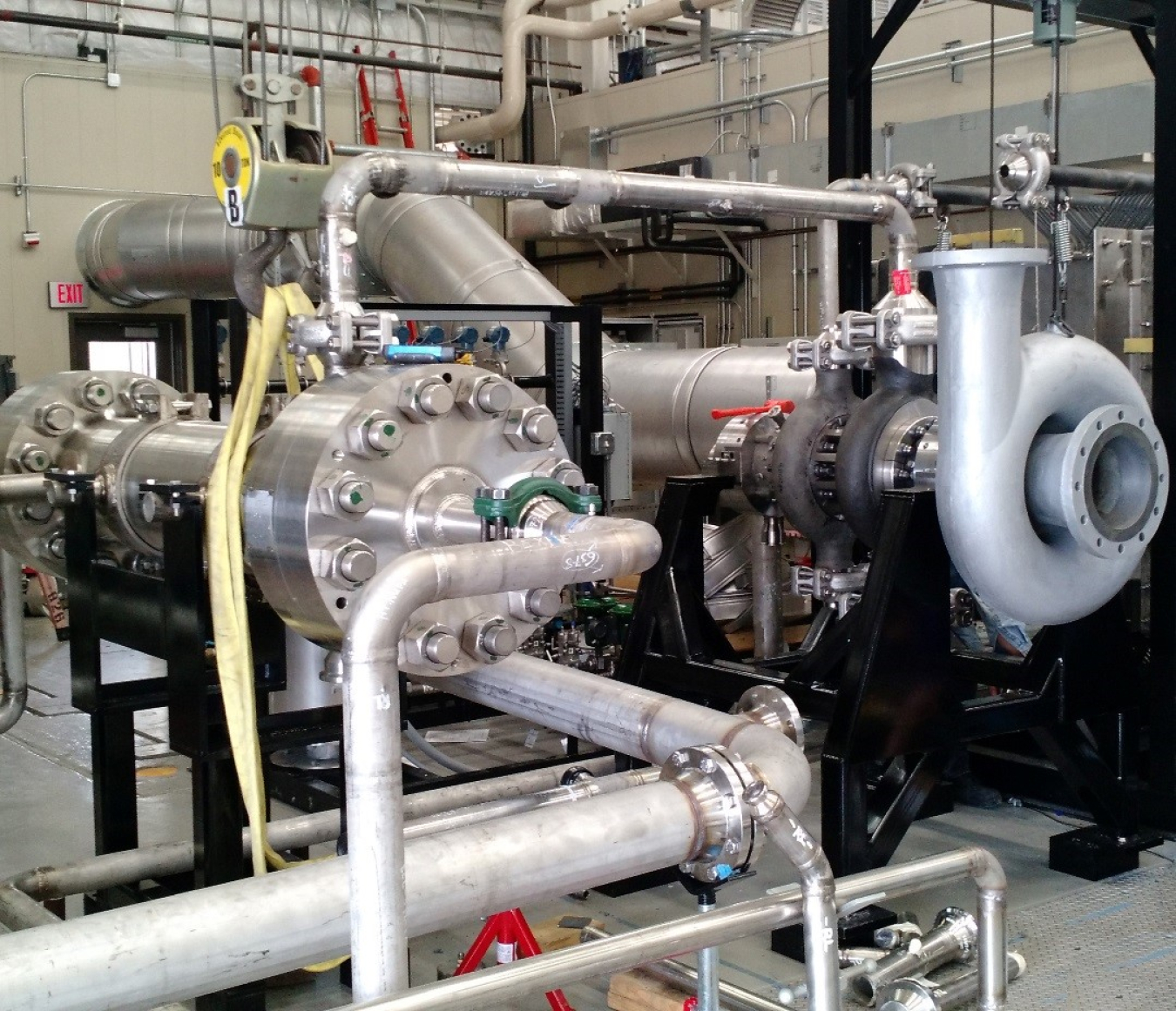Supercritical carbon dioxide (sCO2) power cycles have the potential to reduce the cost of concentrating solar power (CSP) by substantially improvin...
March 2, 2017
The DOE SunShot loop is designed to demonstrate highly efficient turbine expander and recuperator performance for advanced supercritical carbon dioxide concentrating solar power cycles. Photo courtesy of Southwest Research Institute.
Note: This story was updated in April 2019 to include the testing of the world’s largest, highest-temperature supercritical carbon dioxide turbine.
Supercritical carbon dioxide (sCO2) power cycles have the potential to reduce the cost of concentrating solar power (CSP) by substantially improving the efficiency of converting high temperature solar heat into electricity. Through eight years of steady progress on three projects funded by the U.S. Department of Energy Solar Energy Technologies Office (SETO), GE Global Research (GE) and Southwest Research Institute (SwRI) have taken major steps toward commercializing the technology.
Using sCO2—carbon dioxide in a state that combines characteristics of both liquids and gases—as the working fluid in turbine power cycles significantly improves CSP plant efficiency. Rather than using steam to power an electric generator, sCO2 is heated to temperatures greater than 700°C to drive a turbine and create electricity. A sCO2 power cycle uses thermal energy inputs similar to those of a traditional CSP plant, so it generates more electricity for a given amount of heat, improving plant efficiency and lowering the cost of electricity. And because of the physical characteristics of sCO2, the turbines are much smaller than traditional steam-powered turbomachinery. This leads to less material utilization, lower up-front capital costs, and a more cost-effective plant.
SWRI and GE completed successful testing of the largest and highest-temperature sCO2 turbine in the world. The 10 megawatt (MW) turbine, which SETO began funding in 2012, was tested at 1 MW of power. This scale and temperature uses parts similar to those in commercially relevant large-scale industrial power plants, like a turboexpander and recuperator, to advance sCO2 turbine technology. Bearings, seals, and other components were adapted to perform in a sCO2 environment at 250 times atmospheric pressure and over 700°C—operating conditions that exceed those of today’s most advanced steam turbines. One unique advantage of this turbine, and sCO2 power cycles in general, is the remarkably small size of the turbomachinery for the power obtained—while a steam or gas turbine would be the size of a truck, the equivalent sCO2 turbine is the size of a desk. The smaller size has the potential to reduce equipment costs and enable higher efficiency.
In conjunction with this work, SETO awarded two projects to the GE and SwRI team to develop advanced components for sCO2 technology. In one, GE developed prediction models to validate the long-term reliability of the bearings and seals that are necessary to ensure the 30-year lifetime required for the turbomachinery. In the second, the team created an optimal compression system to help a sCO2 power block consistently operate at different temperatures and pressures. Because of the unique properties of the sCO2 fluid, the density and flow of the fluid can vary over a much larger range in a sCO2 power cycle, making compressor design integral to developing an efficient power cycle over a wide variety of operating conditions.
Due in large part to the team’s success at making CSP technology more efficient and reliable, in October 2016 the Energy Department selected GE, SwRI, and the Gas Technology Institute for an $80 million award to build a 10 MW pilot facility in San Antonio. This team has completed design and obtained permission to build a fully integrated system to demonstrate the feasibility of this high-efficiency, low-cost power cycle. This test facility will advance sCO2 power cycle technology to demonstration at utility-scale—one of the last steps to commercialization.
Successfully demonstrating the viability of the technology goes beyond solar generation and can also be used for geothermal, nuclear, and fossil technologies. If successful, the facility has the potential to be significantly more efficient than current steam engine power plants, lowering costs and inching the solar industry closer to commercializing sCO2 technology.
Learn more about the Solar Energy Technologies Office’s concentrating solar power work.

